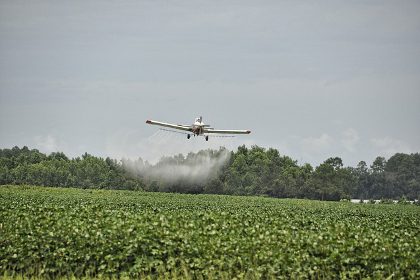
Disturbing New Evidence About What Common Pesticides Can Do to Brains
For defense against the fungal pathogens that attack crops—think the blight that bedeviled Irish potato fields in the 19th century—farmers turn to fungicides. They're widely sprayed on fruit, vegetable, and nut crops, and in the past decade they've become quite common in the corn and soybean fields.
April 13, 2016 | Source: Mother Jones | by Tom Philpott
For defense against the fungal pathogens that attack crops—think the blight that bedeviled Irish potato fields in the 19th century—farmers turn to fungicides. They’re widely sprayed on fruit, vegetable, and nut crops, and in the past decade they’ve become quite common in the corn and soybean fields. (See here and here for more.) But as the use of fungicides has ramped up in recent years, some scientists are starting to wonder: What are these chemicals doing to the ecosystems they touch, and to us?
A new paper in the peer-reviewed journal Nature Communications adds to a disturbing body of evidence that fungicides might be doing more than just killing fungi. For the study, a team of University of North Carolina Neuroscience Center researchers led by Mark Zylka subjected mouse cortical neuron cultures—which are similar in cellular and molecular terms to the the human brain—to 294 chemicals “commonly found in the environment and on food.” The idea was to see whether any of them triggered changes that mimicked patterns found in brain samples from people with autism, advanced age, and neurodegenerative diseases like Alzheimer’s.
Eight chemicals fit the bill, the researchers found. Of them, the two most widely used are from a relatively new class of fungicides called “quinone outside inhibitors,” which have surged in use since being introduced in US farm fields in the early 2000s: pyraclostrobin and trifloxystrobin.
Now, it’s important to note, Zylka told me in an interview, that in vitro research like the kind his team conducted for this study is only the first step in determining whether a chemical poses risk to people. The project identified chemicals that can cause harm to brain cells in a lab setting, but it did not establish that they harm human brains as they’re currently used. Nailing that down will involve careful epidemiological studies, Zylka said: Scientists will have to track populations that have been exposed to the chemicals—say, farm workers—to see if they show a heightened propensity for brain disorders, and they’ll have to test people who eat foods with residues of suspect chemicals to see if those chemicals show up in their bodies at significant levels.
That work remains to be done, Zylka said. “What’s most disturbing to me is that we’ve allowed these chemicals to be widely used, widely found on food and in the environment, without knowing more about their potential effects,” he said.
How widely are they used? The paper points to US Geological Survey data for pyraclostrobin, a fungicide that landed on the UNC team’s list of chemicals that trigger “changes in vitro that are similar to those seen in brain samples from humans with autism, advanced age and neurodegeneration.” It’s marketed by the German chemical giant BASF’s US unit under the brand name Headline, for use on corn, soybeans, citrus fruit, dried beans, and more. BASF calls Headline the “nation’s leading fungicide.” The USGS chart below shows just how rapidly it has become a blockbuster on US farm fields.
